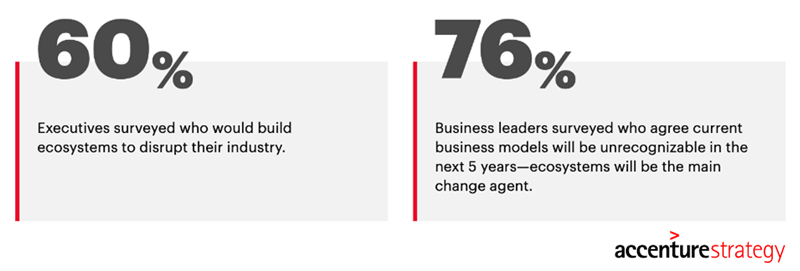You may or may not be aware, but we are currently in the middle of a seismic shift in the way business is being done.
The conventional playbooks for sales, marketing, and channel development are being ripped up in real-time as we see major changes evolving in the way people work, the way products and solutions are being bought and sold and in relation to how we are allowed to store and manage user data. If you want to get caught up on all of this, I highly recommend you take a look at the great content Jay McBain at Forrester has written on these topics - plus this excellent white paper courtesy of Pandium.
All these trends point to the rise of ecosystems and the need for enterprises to embrace and manage strategies that maximize their potential.

But what does this really mean? Is it another buzzword which we’ll hear about for the next few years but just keep applying the same tried and tested strategies regardless? In my opinion, absolutely not … let me explain.
What is a Business Ecosystem?
This blog, courtesy of Greg Sarafin / E&Y does a better job of answering this question than I could.
"A business ecosystem is a purposeful business arrangement between two or more entities (the members) to create and share in collective value for a common set of customers. Every business ecosystem has participants, and at least one member acts as the orchestrator of the participants”
So based on that definition, anyone who has a business with at least one employee, one supplier, and one client has an ecosystem (and maybe even a bot selling to another bot the way things are going).
At the other end of the scale - a global business with thousands of customers, employees, partners, suppliers, etc. also has an ecosystem - it’s just a lot more complex. The owner/orchestrator of the ecosystem is the core business with a direct and vested interest in maximizing its ecosystem members' potential.
But in today’s world, there is more to consider than just the primary business ecosystem your organization needs to orchestrate. There are other ecosystem opportunities out there, and the companies that start to embrace these will have a significant advantage moving forward.
Here are some examples:
Marketplaces
Per Jay McBain, there was more growth in revenue going through marketplaces in the first few months of COVID than in the past ten years combined. Marketplaces recognize that the customer wants products and solutions to be packaged and delivered to them in a unified way as already proven beyond doubt in our consumer lives.
Marketplaces are now becoming mission-critical in b2b. Obvious examples are the Salesforce App Exchange and AWS Marketplace but there are opportunities for organizations of all sizes to embrace this model, either as an ecosystem owner/orchestrator or as a member/participant.
Communities
This is a very broad categorization for a wide range of potential ecosystems. An extreme example of this type of ecosystem is LinkedIn - a global directory of business professionals orchestrated by a company now valued at approximately $30BN.
360ecosystems technology helps support some recent examples of great niche ecosystems - for example the Partnership Leaders member portal. And alongside new internet-era communities, there is also a great opportunity for more traditional ecosystems like trade organizations and networking groups to modernize and embrace ecosystem orchestration. Not to mention communities that can change the world for the better if they are well organized and orchestrated.
Aggregator Owned
Similar in nature to Marketplaces, the key difference in this type of ecosystem is that there is a clear and visible lead owner/orchestrator (aggregator) who directly interfaces and supports the buyers and sellers involved in the ecosystem, providing services and support as needed. Those buyers and sellers are the aggregators' customers in this type of ecosystem.
Aggregators can benefit from taking an established or developing ecosystem and more effectively orchestrating its members. For example, Pax8 has done a great job of challenging traditional distribution in this way but there are also significant opportunities for modernization in distribution itself (and other traditional aggregator-based business models) through more effective ecosystem orchestration.
The Ecosystem Orchestration Challenge
So if we all agree that effective ecosystem orchestration is going to be a key priority for businesses of all shapes and sizes AND this needs to be delivered through the lens of a world-class customer experience, the real question is how do we actually go about embracing the ecosystem era opportunity.
Tips to consider:
Build a Plan of Attack
The first step is to truly understand your own ecosystem and the wider opportunity to drive or participate in ecosystems that are strategically aligned with your enterprise. You need to take a detailed look at the roles that each partner plays, why they play them, and how you measure impact. This can be easier said than done and requires a process-driven, structured approach, similar to the planning of any major strategic project.
I can’t overstate how important this step is. All too often we rush to tactical or technical solutions on ecosystem engagement without looking at the bigger picture and how best to prioritize investment and efforts. It’s also key to establish a clear framework for identifying and measuring KPIs against your identified priorities - the more granular the better.
Tool your Business to Support Ecosystem Orchestration
Technology
Although a relatively new genre, there is a growing range of cloud based solutions that really focus on the automation of ecosystem orchestration. 360ecosystems is part of this vendor community, working with a range of other great companies who are all focused on driving results for ecosystem-focused businesses.
If you are a Gartner member, this report provides a good summary of many of these solutions as does this report for Forrester subscribers.
This should not be a case of selecting new technology for new technologies' sake - but of choosing a toolset that will help you drive your most pressing priorities as identified in the ‘plan of attack’ stage of the process. There is an increasing need to pivot away from end-user marketing automation solutions which are now no longer viable given the changes being made around data privacy and the use of personal data.
It’s also important to try and be smart in terms of automation. For example, think about the ecosystem user experience. The legacy approach would be to solve this in silos with a website for customers, intranet for employees, PRM system for partners, Sales Enablement platform for sales reps, etc. 360ecosystems can create all these experiences dynamically around the persona of the user (without the need for multiple systems) whilst also integrating with any number of existing or future applications into a single experience. You will have a far better chance with platforms like this in the mix as opposed to point solutions for each type of user, or custom building expensive and hard-to-maintain user experience using DXP or CMS technology.
Team
And tooling isn’t only about technology. I’ve started to notice some new (and in some cases very senior) job titles appearing on LinkedIn. It’s no longer a novelty to hire an ‘SVP or VP of Ecosystem’.
But it’s not just about the leadership team - the whole organization has to be built around the enablement, support, and maximization of its ecosystems. In this regard, delegation is key - you can only truly support the contextual needs of different types of ecosystem members if you enable the people in your organization who are responsible for those relationships to do it for themselves. For example, who has more of a chance of providing relevant and up-to-date content, communications, and support for your resale partners who focus on a specific product in a specific region/language - a global marketing administrator at HQ or the local partner account manager with responsibility for those named accounts who knows the companies and speaks their language?
Leaders who build, educate, and energize teams around the ecosystem opportunity and how to maximize it will succeed in the same way leaders who embraced CRM and sales and marketing automation did in the last decade.
Measure, Analyze and Refine - Continuously
Another concept that has been proven beyond all doubt in the consumer world (and in more mature b2b strategies such as marketing automation/lead nurturing) is that data is going to play a huge role in how successful your ecosystem orchestration will be. If you do not intimately understand the engagement behavior or your ecosystem members (and how to interpret and act on this) it will be extremely difficult to make educated decisions and investments moving forward. Much like AB marketing testing, you won’t really know what’s working until you start executing, but the ability to see and understand this in real-time will be crucial once you are.
Also vital is the need to be able to adjust and refine at the speed of the business, at all levels. Back to the point about delegation - your local partner relationship manager needs to be able to take responsibility for analyzing and optimizing their own approach in the same way as the strategic leader who is making the big calls on where overall budgets should be focused based on what’s producing the best results.
The right technologies and methodologies will play a big role in ensuring you can succeed in driving your strategy this way, as will the identification of the KPIs at the beginning of the process (back to our plan of attack again).
So What Next?
For me, the biggest step needed is to secure organizational agreement that your company must establish a clear ecosystem orchestration strategy and the supporting business structure to maximize this opportunity (and not be left behind).
Once this is clear strategically, it will become far easier to make decisions on your plan including the required investments - particularly in relation to team and technology.
Your Ecosystem Orchestration Platform
The 360insights Ecosystem is a dynamic platform designed to revolutionize ecosystem management. It's a single pane of glass experience that includes an integration of services that empower ecosystem partners to thrive. Think: tech, expert services, and solution providers, all as a comprehensive package.
360insights offers a competitive advantage, enabling partners to unlock new opportunities and optimize their strategic initiatives. This robust ecosystem supports partners in enhancing their market presence, driving growth, and achieving shared success. Through effective ecosystem management, 360insights ensures that every partner is equipped with the tools and insights needed to excel in a rapidly evolving marketplace, creating unparalleled value and long-term success for all involved.
If there’s any way I can help along the way, or you’d like to discuss more on this topic, I would love to hear from you.
Learn more about 360insights go-to-market portal here, or discover more about 360ecosystems by reading our eBook - Ecosystem Orchestration has landed and is here to stay.






